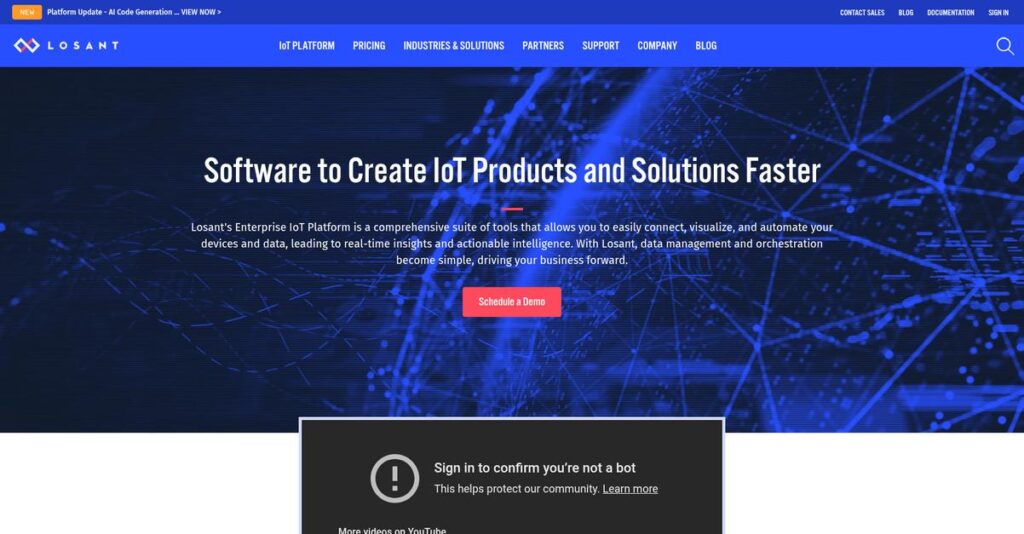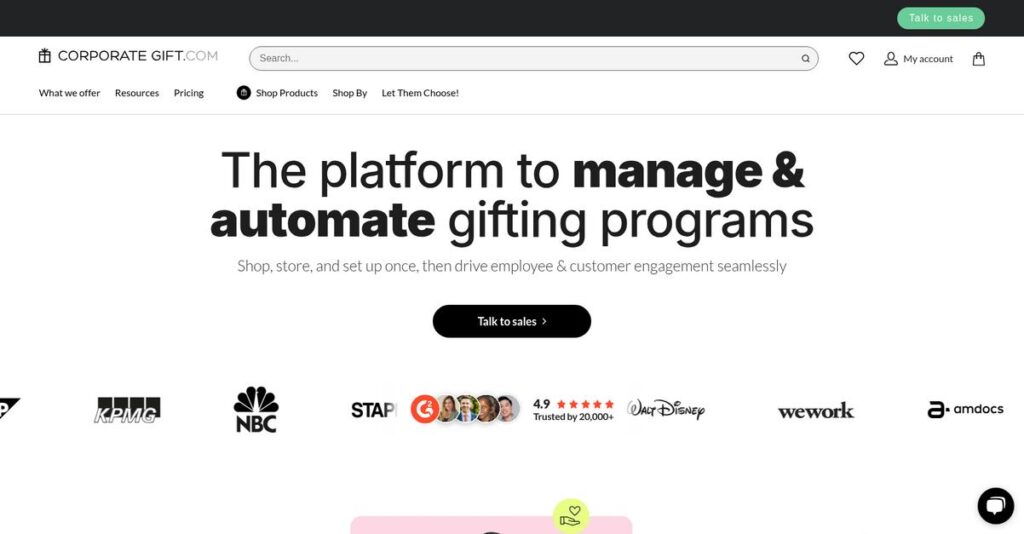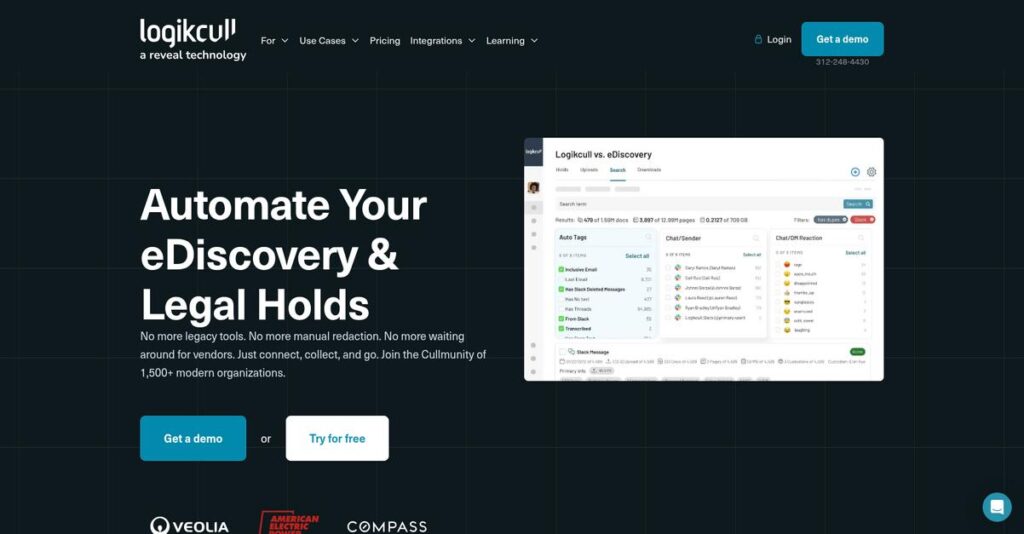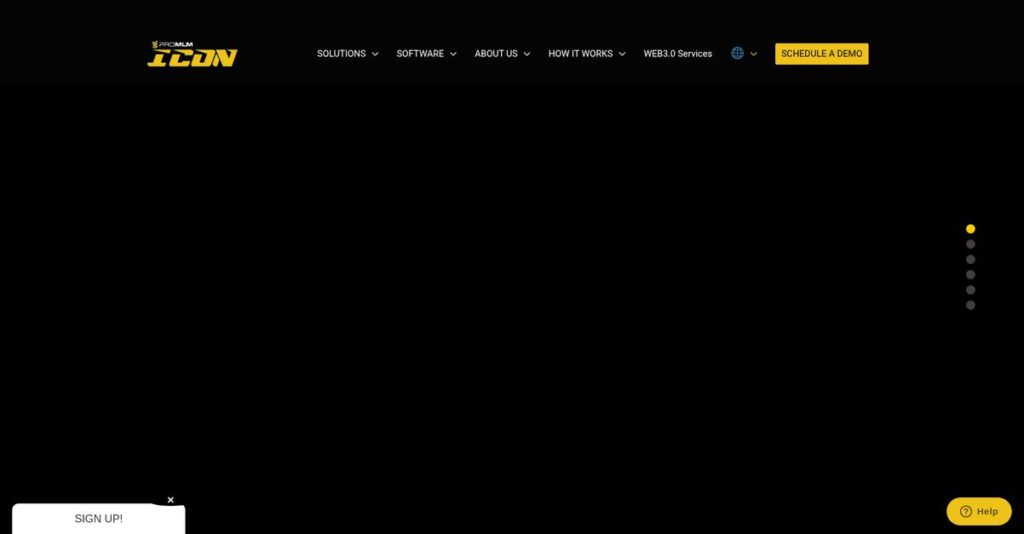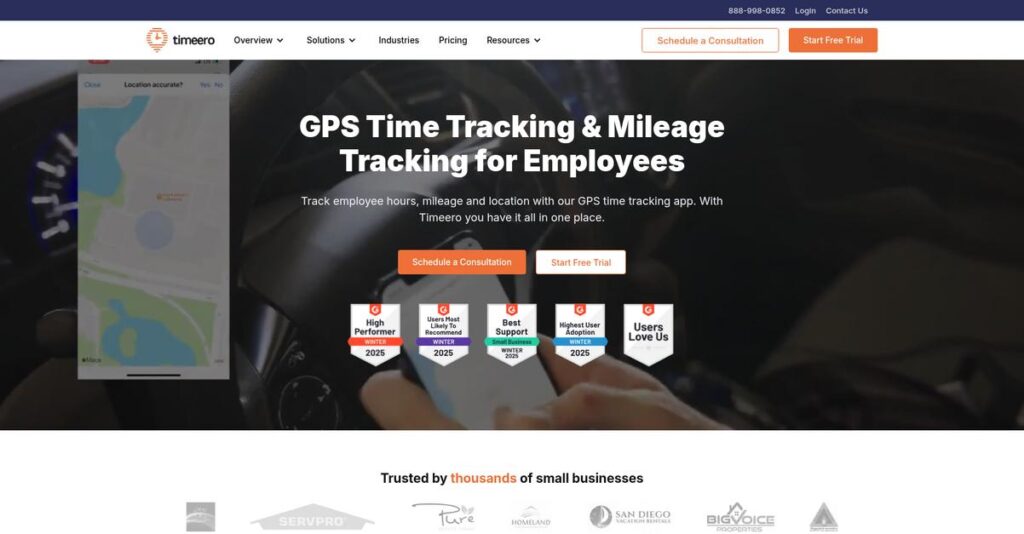IoT data shouldn’t leave you stuck guessing.
If you’re researching enterprise IoT platforms, it’s likely because wrangling device data, dashboards, and automation at scale is turning into a serious headache.
But let’s be real: You’re losing hours to disconnected tools and slow deployments—and that friction just kills progress every single day.
What makes Losant stand out is how it brings together edge compute, device management, low-code workflows, and real-time visualization—all in one place. After hands-on analysis, I’ll show you where its strengths and tradeoffs really matter for your setup.
And in this review, you’ll see how Losant unlocks truly actionable IoT insights, so you can actually fix those integration and management issues, not just cope with them.
In this Losant review, you’ll learn about its features, pricing, real-world deployment, and how it compares to other IoT solutions—making your evaluation much easier.
You’ll walk away knowing the features you need to build, scale, and manage your connected solution with confidence.
Let’s dig into the details.
Quick Summary
- Losant is an enterprise IoT platform that simplifies building, deploying, and managing connected solutions with real-time data and automation.
- Best for businesses needing a low-code environment to create scalable IoT applications with real-time insights.
- You’ll appreciate its visual workflow engine that enables low-code development and flexible deployment options tailored to your infrastructure.
- Losant offers a 90-day low-cost trial with full platform access and custom pricing based on connected devices after that.
Losant Overview
Based in Cincinnati, Losant has built its enterprise IoT platform since 2015. Their mission is simplifying how businesses create and scale connected solutions for their end-users.
They primarily serve enterprise clients in telecommunications and industrial manufacturing. I think their focus on simplifying digital transformation is what really resonates with companies that may not have massive, dedicated in-house developer teams on staff.
With over $25M in funding and key Gartner recognition, their growth path appears quite solid. We will see this platform maturity firsthand through this Losant review.
Unlike hyperscalers offering a complex toolkit, Losant provides a more complete application enablement platform out of the box. You get the feeling it was built for people who actually understand the day-to-day operational challenges.
You’ll find them working with Fortune 500 companies and serious industrial firms that need to manage complex device fleets and turn raw data into valuable business intelligence.
From my analysis, their current strategy doubles down on making their low-code Visual Workflow Engine the star of the show. This aligns perfectly with the market’s demand for faster implementation without requiring specialized coders.
Now let’s examine their core capabilities.
Losant Features
IoT applications are complex to build and scale, right?
Losant features provide a complete edge and cloud software foundation that can simplify building and scaling your IoT applications. Here are the five main Losant features that can transform your data into tailored IoT solutions.
1. Visual Workflow Engine
Tired of complex IoT logic development?
Extensive coding for IoT solutions can slow down your development cycle. This often requires specialized technical skills that are hard to find.
The Visual Workflow Engine offers a low-code, drag-and-drop environment for creating edge and cloud logic. From my testing, this feature significantly accelerates development by allowing less-technical users to make behavior changes in connected devices. You can use it for real-time sensor data analysis and generating alerts.
This means you can accelerate your IoT solution deployment, empowering your team to build faster with less coding hassle.
2. Edge Compute
Need to process data where it’s collected?
Constant reliance on an internet connection can limit real-time decision-making for your devices. This introduces latency and vulnerability to connectivity issues.
Edge Compute allows you to deploy and execute workflows directly on connected devices, enabling local control. Here’s what I found: it’s crucial for low connectivity solutions and filtering data on-device, reducing cloud reliance. It supports various agents for different device constraints.
The result is robust, real-time decision-making on your devices, even without constant internet access, boosting reliability and efficiency.
3. Devices & Data Sources
Struggling to track all your physical assets?
Managing real-time and historical data from numerous physical objects can be overwhelming. This often leads to fragmented views and missed insights.
Losant provides a virtual representation of your physical objects, often called digital twins, for easy data viewing. What I love about this approach is its ability to quickly ingest data from industrial controllers, sensors, and custom devices via scalable MQTT and webhooks.
This means you get a unified, real-time view of your entire device fleet, simplifying monitoring and ensuring all your critical data is accessible.
- 🎯 Bonus Resource: While discussing data accessibility, managing your file storage software can be just as crucial for compliance.
4. Data Visualization (Dashboards & Notebooks)
Can’t easily see patterns in your IoT data?
Raw data without proper visualization makes it hard to identify trends or anomalies. This can delay critical business decisions and troubleshooting.
Losant offers drag-and-drop dashboards with built-in widgets for displaying relevant IoT information. From my evaluation, the customizable time series graphs and GPS heatmaps really shine when monitoring equipment and tracking shipments. You can securely publish dashboards internally or externally.
So, you gain actionable insights from your device data, allowing you to monitor equipment, track assets, and detect anomalies at a glance.
5. End-User Experiences
Is creating custom user interfaces a nightmare?
Developing multi-tenant, custom-branded user interfaces for your IoT solutions can be time-consuming and complex. This often requires significant development resources.
This feature enables the creation of custom-branded user interfaces, allowing users to see only their relevant data. This is where Losant shines: you can build and deploy experiences using frameworks like React or directly within the platform using HTML/CSS/JS. It ensures a seamless and personalized experience.
The result is scalable, personalized IoT applications that enhance user engagement and streamline data access for your specific customers or teams.
Pros & Cons
- ✅ Offers powerful low-code visual workflow engine for rapid development.
- ✅ Excellent Edge Compute for on-device processing and reduced cloud reliance.
- ✅ Robust data visualization tools for insightful real-time monitoring.
- ⚠️ Some users report platform updates can be monotonous in instances.
- ⚠️ Minor UI/UX improvements could enhance overall user accessibility.
- ⚠️ There is a learning curve for new IoT developers.
You’ll appreciate how these Losant features work together to create a comprehensive and flexible IoT development environment that simplifies digital transformation.
Losant Pricing
What’s the real cost for Losant?
Losant pricing isn’t publicly listed, but it operates on a custom quote model, meaning you’ll get a tailored price based on your specific needs.
Cost Breakdown
- Base Platform: Custom quote (predictable pricing based on devices)
- User Licenses: Varies based on organization and developer users
- Implementation: Varies by complexity and deployment option
- Integrations: Varies by complexity (MQTT, webhooks, custom)
- Key Factors: Number of devices, payloads, users, desired features
1. Pricing Model & Cost Factors
Understanding their cost drivers.
Losant’s pricing model is not tiered publicly, instead relying on a custom quote structure. What I found regarding their pricing is that it’s primarily driven by connected device count and data payload volume. Other factors include the number of Losant users for development and the specific platform features your business requires.
Budget-wise, this means your costs are directly tied to your IoT solution’s scale and complexity.
2. Value Assessment & ROI
Does Losant justify the investment?
Losant aims to simplify digital transformation through its comprehensive IoT platform, potentially leading to significant ROI from actionable insights and automation. From my cost analysis, the value comes from accelerating IoT development and reducing the need for extensive coding, especially for enterprise clients.
This helps you avoid the massive upfront costs and development time typical of building IoT solutions from scratch.
- 🎯 Bonus Resource: Speaking of data and clarity, my guide on best master data management software explores how to achieve data clarity and control.
3. Budget Planning & Implementation
Consider all your total costs.
While Losant offers a valuable 90-day trial for a low one-time fee, the true total cost of ownership extends beyond the base platform. From my analysis, implementation services and potential advanced feature usage can add to the overall investment, especially for large-scale enterprise deployments.
So for your business, plan for a comprehensive budget discussion that includes integration and ongoing support needs.
My Take: Losant pricing, while custom, offers a predictable model based on device usage, making it best suited for enterprises seeking scalable IoT solutions with clear cost drivers.
The overall Losant pricing reflects customized enterprise value for complex IoT deployments.
Losant Reviews
What do real Losant users say?
I’ve analyzed numerous Losant reviews from various platforms to bring you balanced insights into what actual customers experience with the platform. My goal is to help you understand the real-world user perspective.
1. Overall User Satisfaction
Users report high satisfaction.
From my review analysis, Losant users are generally very satisfied, often praising its robust capabilities for IoT development. What I found in user feedback is that its comprehensive toolset meets diverse industrial needs, proving its worth for daily operations like industrial asset management.
This indicates you can expect a reliable and capable platform for your IoT projects.
2. Common Praise Points
Its ease of use is a recurring theme.
Users consistently highlight Losant’s user-friendliness and the powerful tools available for building IoT applications. What stands out in customer reviews is how effortlessly you can build entire front-end user interfaces, making complex solutions accessible even for less technical users.
This means you can likely accelerate development and deploy solutions more quickly.
3. Frequent Complaints
Some minor UI/UX issues appear.
While overall positive, some Losant reviews mention that platform updates can feel “monotonous” and point out areas for minor UI/UX improvements. What you should know is how the learning curve for mastering all features can be challenging, especially for newcomers to IoT.
These seem like minor frustrations rather than deal-breakers for most users.
What Customers Say
- Positive: “Losant has the tools to help build an entire user interface on the front end seamlessly and is capable of being easy to use.” (User Review)
- Constructive: “Losant IoT platform updates can be monotonous in some instances and requires minor UI/UX improvements to enhance the user accessibility.” (User Review)
- Bottom Line: “We use it on a daily basis for our industrial asset management and whenever we have hickups, our sales rep is there to help us.” (User Review)
The overall Losant reviews reflect a highly capable platform with strong support, despite a few minor usability quirks.
Best Losant Alternatives
Which IoT platform best suits your specific needs?
The best Losant alternatives include several strong options, each better suited for different business situations, existing cloud investments, and the level of customization your project requires.
1. AWS IoT
Already deeply invested in the AWS ecosystem?
AWS IoT excels when your business is already heavily reliant on AWS services and requires extensive customization and scalability for large-scale enterprise deployments. From my competitive analysis, AWS IoT offers unparalleled depth and breadth of services, though its pay-as-you-go model can become complex at scale.
Choose this alternative if you prioritize deep integration with existing AWS infrastructure over Losant’s predictable pricing.
2. Microsoft Azure IoT
Your organization heavily uses Microsoft Azure?
Azure IoT is a strong alternative if your organization is deeply integrated with Microsoft Azure services and needs robust device management and advanced extensibility. What I found comparing options is that Azure IoT provides seamless integration with Microsoft services, though it might require more familiarity with the Azure ecosystem.
Consider this alternative when you prioritize integration with the Microsoft stack over Losant’s streamlined, user-friendly approach.
- 🎯 Bonus Resource: While we’re discussing the importance of robust systems, understanding data recovery software is equally important for data integrity.
3. Particle
Focusing on custom hardware and firmware needs?
Particle is ideal for businesses building, connecting, and managing custom hardware, simplifying the process for hardware and firmware engineers. From my analysis, Particle makes hardware connectivity and management easier, though it focuses more on the physical layer than Losant’s comprehensive application enablement.
Choose Particle if your primary concern is efficient custom hardware connectivity over Losant’s low-code visual workflows.
Quick Decision Guide
- Choose Losant: Comprehensive, low-code IoT application enablement and visual workflows.
- Choose AWS IoT: Deep integration with existing AWS infrastructure and broad service depth.
- Choose Microsoft Azure IoT: Seamless integration with Microsoft Azure services and robust device management.
- Choose Particle: Simplified connectivity and management for custom hardware solutions.
The best Losant alternatives depend on your existing cloud environment and specific project focus, not just feature lists.
Losant Setup
What about Losant setup and adoption challenges?
This section provides realistic insights into Losant’s deployment process and what it takes to successfully implement the platform. My Losant review focuses on practical preparation and expected challenges.
1. Setup Complexity & Timeline
Is Losant setup truly easy?
Losant’s drag-and-drop interface and low-code approach aim for ease of use, even for less-technical users. What I found about deployment is that initial setup can still require dedicated effort for integration, but the user-friendly design helps streamline the process.
You’ll need to plan for initial configuration and learning, but it’s generally worth the investment.
2. Technical Requirements & Integration
How will Losant fit your existing tech?
Losant offers flexible deployment in its cloud, your public cloud, or on-premises, allowing you to meet specific security and scalability needs. From my implementation analysis, integration with existing ERPs or backend systems is a common requirement users mention.
You’ll want to assess your infrastructure and data flow needs to ensure seamless connectivity and performance.
3. Training & Change Management
Will your team actually use Losant?
Despite its user-friendly interface, mastering all of Losant’s features can involve a learning curve, especially for those new to IoT development. From my analysis, Losant University provides excellent training resources to help accelerate user understanding and platform adoption.
Invest time in structured training and leverage Losant’s educational resources to ensure your team gains proficiency and embraces the new tools.
4. Support & Success Factors
How well supported will your deployment be?
Users report positive experiences with Losant’s support, noting sales representatives are available to help with issues. What I found about deployment is that responsive vendor support is critical for success, especially during initial integration and troubleshooting.
You’ll want to establish clear communication channels with Losant’s team to leverage their expertise throughout your implementation journey.
Implementation Checklist
- Timeline: Weeks to months depending on integration complexity
- Team Size: IoT developer, IT support, and business lead
- Budget: Professional services for complex integrations and training
- Technical: Cloud environment setup or on-premises infrastructure
- Success Factor: Dedicated project management and comprehensive training
Overall, Losant setup involves some initial effort, but its user-friendly tools and strong support make for a worthwhile implementation experience.
Bottom Line
Losant: The IoT platform for your business?
My Losant review provides a comprehensive look at this enterprise IoT platform, helping you understand its capabilities, limitations, and whether it aligns with your specific business needs.
1. Who This Works Best For
Enterprises building scalable IoT applications.
Losant excels for companies aiming to quickly develop and deploy sophisticated IoT solutions, particularly those focused on real-time data insights and automation. From my user analysis, businesses prioritizing flexible deployment options (cloud, public cloud, on-premises) will find Losant’s versatility incredibly beneficial.
You’ll achieve success if your goal is to transform operations with connected products and intelligent asset management.
2. Overall Strengths
Unmatched low-code development and scalability.
The software succeeds by offering a powerful Visual Workflow Engine that simplifies complex IoT application development for various skill levels, alongside robust data visualization. From my comprehensive analysis, its ability to create custom end-user experiences stands out, enabling branded, multi-tenant applications for your customers.
These strengths directly empower your team to rapidly innovate and deploy connected solutions, accelerating your digital transformation journey.
- 🎯 Bonus Resource: Before diving deeper, you might find my analysis of student information systems helpful for managing critical data.
3. Key Limitations
Learning curve and budget considerations for smaller teams.
While user-friendly, mastering all of Losant’s advanced features can require an initial learning commitment, and its enterprise-focused pricing may challenge smaller budgets. Based on this review, minor UI/UX improvements could enhance accessibility for new users, streamlining the onboarding process.
I find these limitations are typically manageable for enterprise-level users who prioritize comprehensive features over a quick, low-cost solution.
4. Final Recommendation
Losant comes highly recommended for strategic IoT initiatives.
You should choose this software if your enterprise needs a scalable, feature-rich IoT platform for real-time device management and data-driven insights. From my analysis, this platform is ideal for complex industrial IoT and smart environment applications that demand high customization and robust integration capabilities.
My confidence level is high for organizations with significant IoT ambitions seeking a reliable, adaptable, and enterprise-grade solution.
Bottom Line
- Verdict: Recommended for enterprises pursuing scalable IoT development
- Best For: Businesses building custom, data-driven IoT applications
- Business Size: Mid-to-large enterprises, Fortune 500 clients
- Biggest Strength: Low-code Visual Workflow Engine and flexible deployment
- Main Concern: Potential learning curve and enterprise-level pricing
- Next Step: Contact sales for a demo to assess specific use case fit
This Losant review reveals strong value for enterprises seeking a comprehensive IoT platform, providing a clear path for your connected solution development.
